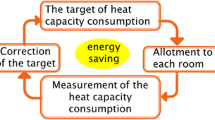Abstract
This article aims to investigate the influence of climate conditions and occupancy levels on the energy savings potential of a novel hydronic circuit configuration in active beam systems. This configuration consists of a room-temperature water loop, which delivers water at a temperature of 22 °C to all the zones in a building. An inherent characteristic of the circuit is that excess heat can be transferred from warm to cold zones when simultaneous need of heating and cooling occurs in the building. This process leads to a reduction of the annual energy use when comparing the novel configuration with traditional ones. The amount of energy reduction depends on the diversity of thermal loads applied to different zones in the building, which are mainly due to climate conditions and occupancy. Therefore, to capture the influence of these two factors on the heat transfer potential of the water loop, a parametric analysis was performed. Three climate locations and five occupancy levels were considered in a model of the system developed in Dymola. Simulation results show that heat transfer between zones leads to annual energy savings of between 7% and 27%, depending on the scenario considered. In absolute terms, the energy savings were between 1.6 kWh/m2 and 6.4 kWh/m2.
Similar content being viewed by others
References
Dansk Standard (2007). DS/EN 15251:2007: Indoor environmental input parameters for design and assessment of energy performance of buildings addressing indoor air quality, thermal environment, lighting and acoustics.
Deru M, Field K, Studer D, Benne K, Griffith B, Torcellini P, Liu B, Halverson M, Winiarski D, Rosenberg M, Yazdanian M, Huang J, et al. (2011). Commercial Reference Building Models of the National Building Stock. U.S. Department of Energy
Fernández J, Kofman E (2014). A stand-alone quantized state system solver for continuous system simulation. Simulation, 90: 782–799.
Filipsson P, Trüschel A, Gräslund J, Dalenbäck J-O (2016). Induction ratio of active chilled beams—Measurement methods and influencing parameters. Energy and Buildings, 129: 445–451.
Guan Z, Wen C (2016). Geometric optimization on active chilled beam terminal unit to achieve high entrainment efficiency. Applied Thermal Engineering, 98: 816–826.
Klöckner A, Linden FLJ van der, Zimmer D (2014). Noise generation for continuous system simulation. In: Proceedings of the 10th International Modelica Conference, Lund, Sweden, pp. 837–846.
Koskela H, Häggblom H, Kosonen R, Ruponen M (2010). Air distribution in office environment with asymmetric workstation layout using chilled beams. Building and Environment, 45: 1923–1931.
Kosonen R, Tan F (2005). A feasibility study of a ventilated beam system in the hot and humid climate: A case-study approach. Building and Environment, 40: 1164–1173.
Lindab (2016). Lindab Solus Supply Air Beam.
Livchak A, Lowell C (2012). Don’t turn active beams into expensive diffusers. ASHRAE Journal, 54(4): 52–60.
Loudermilk KJ, Alexander DS (2012). Efficient space humidity control with active chilled beam systems. ASHRAE Journal, 54(1): 28–38.
Maccarini A, Afshari A, Bergsøe NC, Hultmark G, Jacobsson M, Vorre A (2014). Innovative two-pipe active chilled beam system for simultaneous heating and cooling of office buildings. In: Proceedings of the 13th International Conference on Indoor Air Quality and Climate, Hong Kong, China.
Maccarini A, Afshari A, Hultmark G, Bergsøe NC, Vorre A (2016). Modeling of a novel low-exergy system for office buildings with Modelica. In: Proceedings of the 12th REHVA World Congress, Aalborg, Denmark.
Maccarini A, Hultmark G, Vorre A, Afshari A, Bergsøe NC (2015). Modeling of active beam units with Modelica. Building Simulation, 8: 543–550.
Maccarini A, Wetter M, Afshari A, Hultmark G, Bergsøe NC, Vorre A (2017). Energy saving potential of a two-pipe system for simultaneous heating and cooling of office buildings. Energy and Buildings, 134: 234–247.
Mahdavi A, Mohammadi A, Kabir E, Lambeva L (2008). Occupants’ operation of lighting and shading systems in office buildings. Journal of Building Performance Simulation, 1: 57–65.
Mattsson SE, Elmqvist H, Otter M (1998). Physical system modeling with Modelica. Control Engineering Practice, 6: 501–510.
Murphy J, Harshaw J (2009). Understanding chilled beam systems. Enginnering Newsletter, 38: 1–12.
Rhee KN, Shin MS, Choi SH (2015). Thermal uniformity in an open plan room with an active chilled beam system and conventional air distribution systems. Energy and Buildings, 93: 236–248.
Roth K, Dieckmann J, Zogg R, Brodrick J (2007). Chilled beam cooling. ASHRAE Journal, 49(9): 7–9.
Stein J, Taylor ST (2013). VAV reheat versus active chilled beams & DOAS. ASHRAE Journal, 55(5): 18–32.
Virta M, Butler D, Gräslund J, Hogeling J, Kristiansen L. E, Reinikainen M, Svensson G (2004). Chilled Beam Application Guidebook. Rehva Guidebook No. 5. Brussels: REHVA.
Wetter M, Zuo W, Nouidui TS, Pang X (2014). Modelica Buildings library. Journal of Building Performance Simulation, 7: 253–270.
Acknowledgements
This study was financially supported by ELFORSK, a research and development program administrated by the Danish Energy Association.
Author information
Authors and Affiliations
Corresponding author
Rights and permissions
About this article
Cite this article
Maccarini, A., Hultmark, G., Afshari, A. et al. Transferring heat among building zones through a room-temperature water loop—Influence of climate and occupancy level. Build. Simul. 10, 697–710 (2017). https://doi.org/10.1007/s12273-017-0358-z
Received:
Revised:
Accepted:
Published:
Issue Date:
DOI: https://doi.org/10.1007/s12273-017-0358-z




